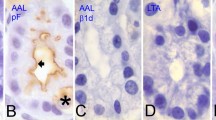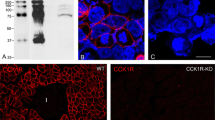Summary
The reaction mechanism by which Aldehyde Fuchsin selectively stains pancreatic B-cell granules is unknown. The participation of either insulin or proinsulin in the reaction is debatable; the stain may be bound by other components of the B-cell granule or its membrane. Sections of pancreas were stained with a variety of basic stains and specific histochemical reagents with and without appropriate blocking agents. No evidence for strong tissue anions associated with the B-cell granule could be found. Aldehyde Fuchsin staining was not abolished by lowering the pH below the point at which all known tissue anions should be protonated. There was no evidence that the Aldehyde Fuchsin staining solution itself generates reactive groups in the tissue. The results of this investigation support a non-ionic, possibly covalent mechanism for Aldehyde Fuchsin staining of pancreatic B-cell granules.
Similar content being viewed by others
References
Bangle, R. (1954) Gomori's paraldehyde-Fuchsin stain. I. Physicochemical and staining properties of the dye.J. Histochem. Cytochem. 2, 291–9.
Buehner, T. S., Nettleton, G. S. &Longley, J. B. (1979) Staining properties of Aldehyde Fuchsin analogs.J. Histochem. Cytochem. 27, 782–7.
Clark, G. (ed.) (1973)Staining Procedures, 3rd edn. Baltimore: Williams and Wilkins.
Fisher, E. R. &Lillie, R. D. (1954) The effect of methylation on basophilia.J. Histochem. Cytochem. 2, 81–7.
Fujita, T. &Takaya, K. (1968) Metachromatic reaction of pancreas B cells to Toluidine Blue: influence of pH on staining.Stain Technol. 43, 329–32.
Gomori, G. (1950) Aldehyde Fuchsin: a new stain for elastic tissue.Am. J. Clin. Pathol. 20, 665–6.
Greenwell, M. V., Nettleton, G. S. &Feldhoff, R. C. (1983) An investigation of Aldehyde Fuchsin staining of unoxidized insulin.Histochemistry 77, 473–83.
Gurr, E. (1956)A practical Manual of Medical and Biological Staining Techniques. New York: Interscience.
Kovacs, K. &Longley, J. B. (1975) Composition of basic fuchsin.J. S. C. Med. Assoc. 71, 11–12.
Evistberg, D. R. (1960) Infrared spectrophotometry. Its use in characterizing histochemical reaction mechanisms.J. Histochem. Cytochem. 14, 853–61.
Kvistberg, D. R., Lazarow, A. &Lester, G. (1966) Staining of insulin with aldehyde fuchsin.J. Histochem. Cytochem 14, 609–11.
Lichtenstein, S. J. &Nettleton, G. S. (1980) Effects of fuchsin variants in Aldehyde Fuchsin staining.J. Histochem. Cytochem. 28, 683–8.
Lillie, R. D. (1977)H. J. Conn's Biological Stains. pp. 604–5. Baltimore: Williams and Wilkins.
Lillie, R. D. &Fullmer, H. M. (1976)Histopathologic Technic and Practical Histochemistry. New York: McGraw-Hill.
Funa, L. G. (ed.) (1968)Manual of Histologic Staining Methods of the Armed Forces Institute of Pathology, 3rd edn. New York: McGraw-Hill.
Mancini, A. M., Frizzera, G. &Vicchi, A. (1966) Histochemical properties of insular B cells after short tryptic digestion.Histochemie 6, 301–9.
Mander, S. K., Mander, L. N. &Charmichael, C. (1968) The staining mechanism of Aldehyde Fuchsin with reference to the oxytalan fibers in the mouse.J. Histochem. Cytochem.,16, 480–5.
Mescon, H. &Flesch, D. (1952) Modification of Bennett's method for the histochemical demonstration of free sulfhydryl groups in skin.J. Invest. Derm. 18, 261–6.
Morrison, R. J. &Boyd, R. N. (1966)Organic Chemistry, 2nd edn. Boston: Allyn and Bacon.
Mowry, R. W. (1963) The special value of methods that color both acidic and vicinal hydroxyl groups in the histochemical study of mucins with revised directions for the colloidal iron stain, the use of Alcian Blue G8X and their combination with the periodic acid-Schiff reaction.Ann N.Y. Acad. Sci. 106, 402–23.
Mowry, R. W. (1978) Aldehyde Fuchsin staining, direct or after oxidation: problems and remedies with special reference to human pancreatic B cells, pituitaries and elastic fibers.Stain Technol. 53, 141–54.
Mowry, R. W. (1983) Selective staining of pancreatic beta-cell granules.Arch. Pathol. Lab. Med. 107, 464–8.
Mowry, R. W. &Kent, S. P. (1986) The staining of injected insulin in kidneys of mice with aldehyde pararosaniline and its correlation with specific immunostaining.J. Histochem. Cytochem. 34, 1368.
Ortman, R., Forbes, W. F. &Balasubramanian, A. (1966) Concerning the staining properties of aldehyde basic fuchsin.J. Histochem. Cytochem. 14, 104–11.
Proctor, G. B. &Horobin, R. W. (1983) The aging of Gomori's aldehyde fuchsin: the nature of the chemical changes and the chemical structures of the coloured components.Histochemistry 77, 255–67.
Puchtler, H., Meloan, S. N. &Waldrop, F. S. (1979) Aldehyde Fuchsin: historical and chemical considerations.Histochemistry 60, 113–23.
Rosenbloom, A. L. &Rennert, D. M. (1970) Specificity and sensitivity of insulin staining of aldehyde Fuchsin, pseudoisocyanin and Toluidine Blue.Stain Technol. 45, 25–9.
Scott, J. E. (1952) Amplification of staining by Alcian Blue and similar ingrain dyes.J. Histochem. Cytochem. 20, 750–2.
Scott, H. R. &Clayton, B. P. (1953) A comparison of the staining affinities of Aldehyde Fuchsin and Schiff reagent.J. Histochem. Cytochem. 1, 336–46.
Sheehan, D. C. &Hrapchak, B. B. (1980)Theory and Practice of Histotechnology. St. Louis: C. V. Mosby.
Spicer, S. S. (1965) Diamine methods for differentiating mucosubstances histochemically.J. Histochem. Cytochem. 13, 211–34.
Spicer, S. S. &Lillie, R. D. (1959) Saponification as a means of selectively reversing the methylation of tissue basophilia.J. Histochem. Cytochem. 1, 123–5.
Steedman, H. F. (1950) Alcian Blue 8GS: a new stain for mucin.Q. J. Microsc. Soc. 91, 477–9.
Sumner, B. E. H. (1965) A histochemical study of Aldehyde Fuchsin staining.J. Roy. Microsc. Soc. 84, 329–38.
Von Denffer, H. (1973) Bindungsort und Bindungsmodus von aldehyde-fuchsin in dem B-Zellen des Insellapparates. Histochemische und Elektronenmikrokopische Untersuchungen.Histochemie 36, 97–113.
Von Denffer, H. &Mertz, M. (1972) Empfindlichkeit einiger Farbstoffe zum Nachweis von B-Granulain dem Inselzellen des Pankreas wahrend der Ontogenesis.Histochemie 29, 54–64.
Wall, G. (1972) Uber die Anfarbund der Neurolipofuscine mit Aldehydfuchsinen.Histochemie 29, 155–71.
Author information
Authors and Affiliations
Rights and permissions
About this article
Cite this article
Cole, L.J., Nettleton, G.S. A histochemical investigation of the mechanism of Aldehyde Fuchsin staining of pancreatic B-cell granules. Histochem J 20, 635–641 (1988). https://doi.org/10.1007/BF01324083
Received:
Revised:
Issue Date:
DOI: https://doi.org/10.1007/BF01324083




